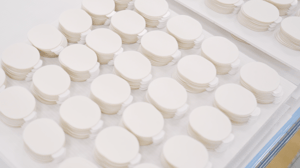While you COULD duct tape a heart monitor to your chest, I’m going to take a wild guess and say that most doctors wouldn’t recommend it.
Adhesive patches primarily attach and stabilize medical devices but can also provide medical aid in other ways. As a flexible material converter, Strouse has helped build many skin patch designs.
Today, we’ll discuss the different uses of adhesive patches for skin, their function, and where to find them.
What Are Adhesive Patches For?
Adhesive patches for the skin are primarily used to stabilize and attach medical devices, administer medication transdermally, or treat wounds. They’re meant to conform to the body's shape and cling on as long as necessary without causing damage upon removal.
WEARABLE MONITORING PATCHES
Many monitor devices are in close contact with the skin and benefit from a skin-safe adhesive patch to hold them in a specific position or support the whole mechanism.
There are many types of wearable monitoring devices, but here are a couple of examples that use adhesive patches.
- Cardiac event monitor patches or ECG patches
Cardiac event monitors can be attached to the bare chest with patches for around two weeks of heart monitoring.
- Diabetes patches
Diabetes patches support diabetes management equipment such as insulin pumps and continuous glucose monitoring systems.
Current diabetes patches primarily hold cartridges and sensors in place, but many companies are attempting to develop transdermal patches that can reliably deliver insulin to patients through the skin.
TRANSDERMAL APPLICATIONS
Certain medications can be transdermally administered through adhesive patches for the skin, which reduces potential complications and allows for spacing out the doses as needed.
Transdermal patches allow medication to soak through the patient’s skin and into the dermis. Microneedle patches are a subsection of transdermal patches that reach deeper into a patient’s skin to deliver drugs more quickly.
WOUND CARE
Adhesive patches are often used to hold dressings, gauze, hydrocolloid patches, and other wound care solutions.
How Do Adhesive Patches Work?
Adhesive patches for skin are typically made from either acrylic or silicone adhesive, depending on the intended length of wear, patient demographic, and device’s function.
HOW LONG DO ADHESIVE PATCHES LAST?
If you’re searching for the best stick-to-skin tape, you’ll probably want to look into the length of wear. However, the wear time for each adhesive patch will vary depending on the adhesive and its function.
For instance, 3M Medical Tape 4576 boasts up to 21 days of skin wear time due to its extended wear acrylate adhesive, but most skin adhesives have a far shorter wear time.
Additionally, a material's adhesive shelf life can change once cut, so you’ll want to consult with your converter to ensure you make the correct choice.
Where Can You Find Adhesive Patches?
If you’re looking for a more general adhesive patch for personal use, there’s sure to be a range of online options. However, what if you’re manufacturing your own device or patch design?
If you’re looking for custom adhesive patches, contacting an adhesive converter might be the best option. Scheduling a project consultation will help you get started on your project today.
For more information about stick-to-skin patches or adhesive converting, check out our Learning Center.







